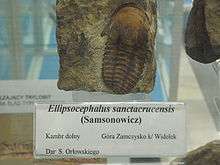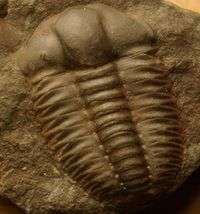Ellipsocephalus
Ellipsocephalus is an extinct genus of blind trilobite that lived during the Cambrian. The genus comprises benthic species inhabiting deep, poorly lit or aphotic habitats.[1] E. hoffi is a common trilobite mainly from central Europe (Czech Republic).[2]

| Ellipsocephalus | |
|---|---|
 | |
| Ellipsocephalus hoffi, Cambrian, Jince Formation, Czech Republic | |
| Scientific classification | |
| Kingdom: | |
| Phylum: | |
| Class: | |
| Order: | |
| Suborder: | Ellipsocephaloidea |
| Family: | Ellipsocephalidae Matthew, 1887 |
| Genus: | Ellipsocephalus Zenker, 1833 |
| Species | |
| |
Distribution
- E. hoffi occurs in the Middle Cambrian of the Czech Republic (Jince Formation).[3]
- E. polytomus has been found near Viken, Näkten lake, Jämtland, Sweden.[4]
- E. sanctacrucensis is known from the Middle Cambrian of Poland (Słowiec Sandstone Formation, Paradoxides insularis and P. pinus-zones, near Brzechów, Holy Cross Mountains).[5]
Description
Ellipsocephalus is approximately oval in shape and definitely convex, and it has opistoparian sutures that are directed slightly outward from the front and the back of the eyes. The central raised area of the headshield (or cephalon) called glabella has approximately parallel sides that are slightly concave and a rounded front. Lateral furrows are indiscernible, as is the occipital ring. The ridges connecting the eye with the glabella (or palpebral lobes) are not distinctly separated from the thin eye ridges. The area between the front of the glabella and the border is somewhat inflated. The free cheeks (or librigenae) are half as wide as the fixed cheek. Some species have genal spines (like E. sanctacrucensis), while the most known species (E. hoffi) has a slightly angular genal angle. Ellipsocephalus has 12 thorax segments. The tailpiece (or pygidium) is 4× wider than long.[6]
Behaviour
Ellipsocephalus and some other primitive micropygous Cambrian genera, such as Bailiella, enroll differently from other trilobites so that the posterior thorax segments and pygidium bend under the thorax. This is called "double enrollment".[6]
References
- "Trends in benthic trilobites".
- "Jince formation".
- S.M. Gon III. "Trilobites of the Jince Formation, Czech Republic". Retrieved 19 October 2012.
- Rushton, A.W.A.; Weidner, T. (2007). "The Middle Cambrian paradoxidid trilobite Hydrocephalus from Jämtland, central Sweden" (PDF). Acta Geologica Polonica. 57 (4): 391–401. Retrieved 30 March 2013.
- Massiak, M.; Žylińska, A. (1994). "Burgess shale-type fossils in Cambrian sandstones of the Holy Cross Mountains" (PDF). Acta Palaeontologica Polonica. 39 (4): 329–340.
- Moore, R.C. (1959). Arthropoda I - Arthropoda General Features, Proarthropoda, Euarthropoda General Features, Trilobitomorpha. Treatise on Invertebrate Paleontology. Part O. Boulder, Colorado/Lawrence, Kansas: Geological Society of America/University of Kansas Press. pp. 1–560. ISBN 0-8137-3015-5.